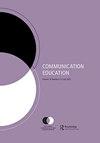The effect of clarity on learning: impacting motivation through cognitive load
IF 0.8
Q3 COMMUNICATION
引用次数: 0
Abstract
ABSTRACTThis study tested the notion that the impact of clarity (i.e., structure) on learning is indirect and occurs, in part, through the reduction of cognitive load and subsequently through students’ motivation to process instructional information. Two hundred fifty-two students were randomly assigned to one of two text-based lessons (clear or unclear) on the topic of social cognitive theory. After being exposed to the material, participants were asked to answer a series of questions regarding the extent to which they found the lesson clear. They also answered questions about their perceived cognitive load, expectations for success on a subsequent examination, perceptions of value, perceived costs, degree of motivation to learn the material, and familiarity with the learning content. After responding to these measures, participants took a test of the material covered in the lesson. Results indicated that, compared to the unclear lesson, students exposed to the clear lesson earned higher examination scores because they experienced reduced cognitive load while learning. Additionally, results revealed an indirect association between clarity and student learning through a decrease in cognitive load and subsequently through an increase in students’ self-efficacy and motivation, and also through students’ emotional interest and motivation.KEYWORDS: cognitive loadclaritymotivationlearning Disclosure statementNo potential conflict of interest was reported by the author(s).清晰对学习的影响:认知负荷对动机的影响
摘要本研究验证了清晰性(即结构)对学习的影响是间接的,并且部分通过认知负荷的减少以及随后通过学生加工教学信息的动机而发生。252名学生被随机分配到以社会认知理论为主题的两门基于文本的课程(清楚或不清楚)中的一门。在接触到材料之后,参与者被要求回答一系列关于他们对课程的理解程度的问题。他们还回答了关于他们感知的认知负荷、对后续考试成功的期望、对价值的感知、感知成本、学习材料的动机程度以及对学习内容的熟悉程度的问题。在对这些措施做出反应后,参与者对课程中涉及的材料进行了测试。结果表明,与不清晰的课程相比,接触清晰课程的学生由于在学习过程中认知负荷减少而获得了更高的考试成绩。此外,研究结果还表明,通过认知负荷的减少,学生自我效能感和动机的增加,以及学生的情感兴趣和动机,清晰度与学生学习之间存在间接关联。关键词:认知负荷清晰性动机学习披露声明作者未报告潜在利益冲突。
本文章由计算机程序翻译,如有差异,请以英文原文为准。
求助全文
约1分钟内获得全文
求助全文
来源期刊

COMMUNICATION EDUCATION
EDUCATION & EDUCATIONAL RESEARCH-
CiteScore
3.10
自引率
34.80%
发文量
47
期刊介绍:
Communication Education is a peer-reviewed publication of the National Communication Association. Communication Education publishes original scholarship that advances understanding of the role of communication in the teaching and learning process in diverse spaces, structures, and interactions, within and outside of academia. Communication Education welcomes scholarship from diverse perspectives and methodologies, including quantitative, qualitative, and critical/textual approaches. All submissions must be methodologically rigorous and theoretically grounded and geared toward advancing knowledge production in communication, teaching, and learning. Scholarship in Communication Education addresses the intersections of communication, teaching, and learning related to topics and contexts that include but are not limited to: • student/teacher relationships • student/teacher characteristics • student/teacher identity construction • student learning outcomes • student engagement • diversity, inclusion, and difference • social justice • instructional technology/social media • the basic communication course • service learning • communication across the curriculum • communication instruction in business and the professions • communication instruction in civic arenas In addition to articles, the journal will publish occasional scholarly exchanges on topics related to communication, teaching, and learning, such as: • Analytic review articles: agenda-setting pieces including examinations of key questions about the field • Forum essays: themed pieces for dialogue or debate on current communication, teaching, and learning issues
 求助内容:
求助内容: 应助结果提醒方式:
应助结果提醒方式:


